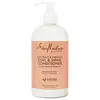What's inside
What's inside
 Key Ingredients
Key Ingredients

No key ingredients
 Benefits
Benefits

 Concerns
Concerns

 Ingredients Side-by-side
Ingredients Side-by-side

Water
Skin ConditioningCetearyl Alcohol
EmollientCaprylic/Capric Triglyceride
MaskingCocos Nucifera Oil
MaskingCetyl Alcohol
EmollientStearyl Alcohol
EmollientBehentrimonium Chloride
PreservativeButyrospermum Parkii Butter
Skin ConditioningParfum
MaskingAloe Barbadensis Leaf Juice
Skin ConditioningHydrolyzed Vegetable Protein Pg-Propyl Silanetriol
Skin ConditioningHibiscus Rosa-Sinensis Flower Extract
HumectantSimmondsia Chinensis Seed Oil
EmollientMangifera Indica Seed Butter
Skin ConditioningMelia Azadirachta Seed Oil
EmollientBrassica Campestris Seed Oil
Skin ConditioningPanthenol
Skin ConditioningSodium Lauroyl Hydrolyzed Silk
Skin ConditioningTocopherol
AntioxidantGlycerin
HumectantGlycine Soja Oil
EmollientHydroxyethylcellulose
Emulsion StabilisingTriethyl Citrate
MaskingCaprylyl Glycol
EmollientBenzoic Acid
MaskingWater, Cetearyl Alcohol, Caprylic/Capric Triglyceride, Cocos Nucifera Oil, Cetyl Alcohol, Stearyl Alcohol, Behentrimonium Chloride, Butyrospermum Parkii Butter, Parfum, Aloe Barbadensis Leaf Juice, Hydrolyzed Vegetable Protein Pg-Propyl Silanetriol, Hibiscus Rosa-Sinensis Flower Extract, Simmondsia Chinensis Seed Oil, Mangifera Indica Seed Butter, Melia Azadirachta Seed Oil, Brassica Campestris Seed Oil, Panthenol, Sodium Lauroyl Hydrolyzed Silk, Tocopherol, Glycerin, Glycine Soja Oil, Hydroxyethylcellulose, Triethyl Citrate, Caprylyl Glycol, Benzoic Acid
Water
Skin ConditioningStearyl Alcohol
EmollientCetyl Alcohol
EmollientButyrospermum Parkii Butter
Skin ConditioningStearamidopropyl Dimethylamine
EmulsifyingGlyceryl Stearate
EmollientPhenoxyethanol
PreservativeParfum
MaskingNeopentyl Glycol Diheptanoate
EmollientLactic Acid
BufferingIsododecane
EmollientEthylhexylglycerin
Skin ConditioningPolyester-11
Skin ConditioningPanthenol
Skin ConditioningDisodium EDTA
Benzyl Benzoate
AntimicrobialIngredients Explained
These ingredients are found in both products.
Ingredients higher up in an ingredient list are typically present in a larger amount.
This ingredient is also known as shea butter. It is an effective skin hydrator and emollient.
Emollients help soothe and soften your skin. It does this by creating a protective film on your skin. This barrier helps trap moisture and keeps your skin hydrated. Emollients may be effective at treating dry or itchy skin.
Shea butter is rich in antioxidants. Antioxidants help fight free-radicals, or molecules that may harm the body. It is also full of fatty acids including stearic acid and linoleic acid. These acids help replenish the skin and keep skin moisturized.
While Shea Butter has an SPF rating of about 3-4, it is not a sunscreen replacement.
Shea butter may not be fungal acne safe. We recommend speaking with a professional if you have any concerns.
Learn more about Butyrospermum Parkii ButterCetyl Alcohol is a fatty alcohol. Fatty Alcohols are most often used as an emollient or to thicken a product.
Its main roles are:
Though it has "alcohol" in the name, it is not related to denatured alcohol or ethyl alcohol.
The FDA allows products labeled "alcohol-free" to have fatty alcohols.
Learn more about Cetyl AlcoholPanthenol is a common ingredient that helps hydrate and soothe the skin. It is found naturally in our skin and hair.
There are two forms of panthenol: D and L.
D-panthenol is also known as dexpanthenol. Most cosmetics use dexpanthenol or a mixture of D and L-panthenol.
Panthenol is famous due to its ability to go deeper into the skin's layers. Using this ingredient has numerous pros (and no cons):
Like hyaluronic acid, panthenol is a humectant. Humectants are able to bind and hold large amounts of water to keep skin hydrated.
This ingredient works well for wound healing. It works by increasing tissue in the wound and helps close open wounds.
Once oxidized, panthenol converts to pantothenic acid. Panthothenic acid is found in all living cells.
This ingredient is also referred to as pro-vitamin B5.
Learn more about PanthenolParfum is a catch-all term for an ingredient or more that is used to give a scent to products.
Also called "fragrance", this ingredient can be a blend of hundreds of chemicals or plant oils. This means every product with "fragrance" or "parfum" in the ingredients list is a different mixture.
For instance, Habanolide is a proprietary trade name for a specific aroma chemical. When used as a fragrance ingredient in cosmetics, most aroma chemicals fall under the broad labeling category of “FRAGRANCE” or “PARFUM” according to EU and US regulations.
The term 'parfum' or 'fragrance' is not regulated in many countries. In many cases, it is up to the brand to define this term.
For instance, many brands choose to label themselves as "fragrance-free" because they are not using synthetic fragrances. However, their products may still contain ingredients such as essential oils that are considered a fragrance by INCI standards.
One example is Calendula flower extract. Calendula is an essential oil that still imparts a scent or 'fragrance'.
Depending on the blend, the ingredients in the mixture can cause allergies and sensitivities on the skin. Some ingredients that are known EU allergens include linalool and citronellol.
Parfum can also be used to mask or cover an unpleasant scent.
The bottom line is: not all fragrances/parfum/ingredients are created equally. If you are worried about fragrances, we recommend taking a closer look at an ingredient. And of course, we always recommend speaking with a professional.
Learn more about ParfumStearyl Alcohol is a type of fatty alcohol from stearic acid. It is a white, waxy compound used to emulsify ingredients.
Fatty Alcohols are most often used as an emollient or to thicken a product. Emollients help soothe and hydrate the skin by trapping moisture.
They are usually derived from natural fats and oils and therefore do not have the same drying or irritating effect as solvent alcohols. FDA allows products labeled "alcohol-free" to have fatty alcohols.
Learn more about Stearyl AlcoholWater. It's the most common cosmetic ingredient of all. You'll usually see it at the top of ingredient lists, meaning that it makes up the largest part of the product.
So why is it so popular? Water most often acts as a solvent - this means that it helps dissolve other ingredients into the formulation.
You'll also recognize water as that liquid we all need to stay alive. If you see this, drink a glass of water. Stay hydrated!
Learn more about Water